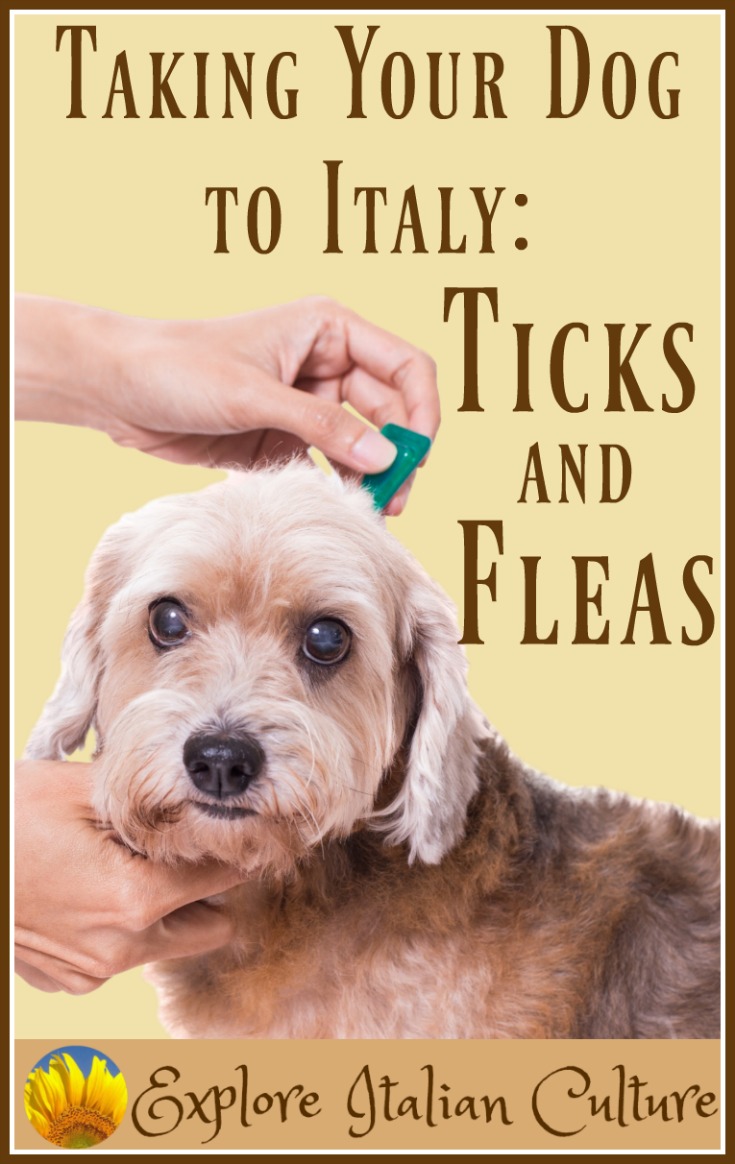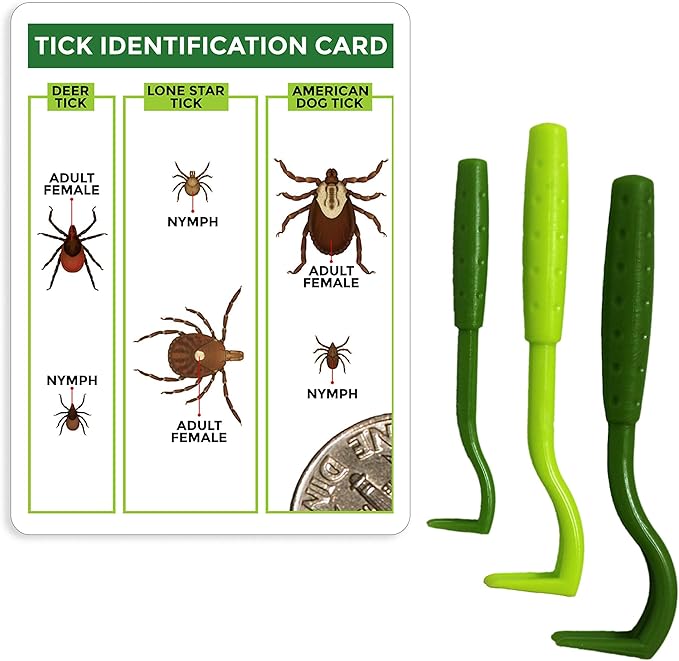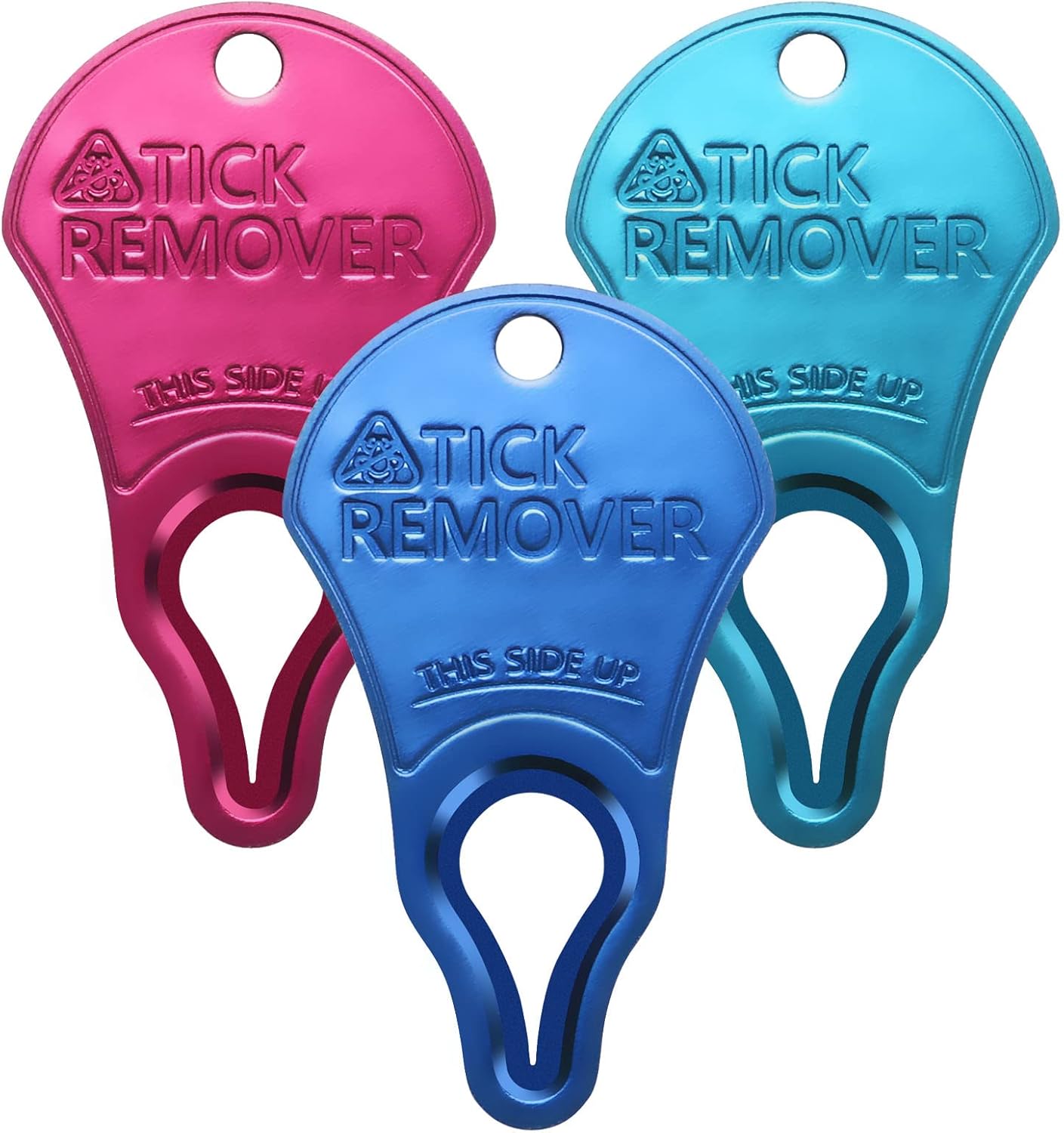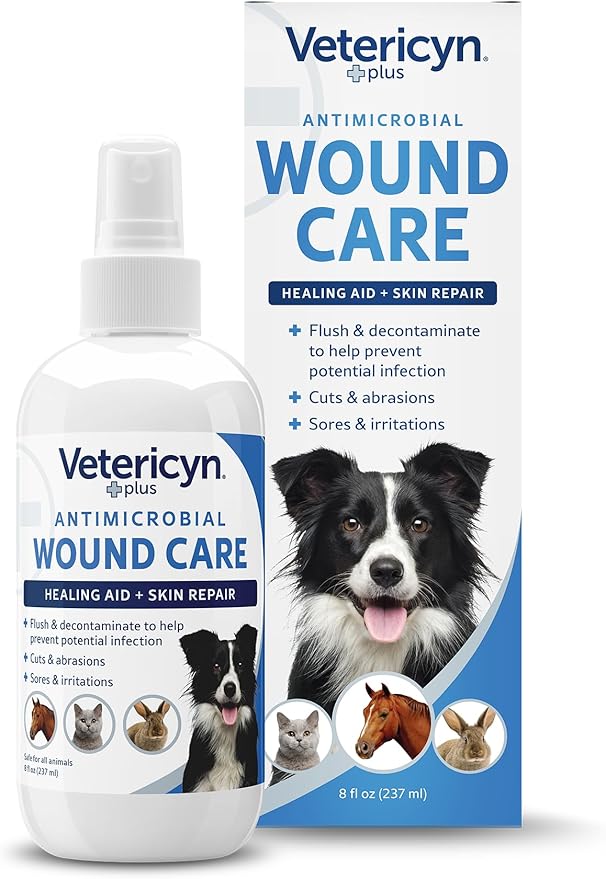Dog tick treatment: why it's important if you're traveling to Italy
Dog tick treatment.
Treating your dog against ticks and fleas is important anyway. And if
you're intending to travel abroad with your pet, it's even more
critical.
Here's why:
Responsible dog owners have their dogs and cats treated against ticks and fleas regularly. If you intend to take your pets out of their home environment, though, it's even more important.
There's no indication that Italy is any worse than anywhere else in Europe for tick- or flea-borne disease - in fact, it's known to be less of an issue here than in other European countries.
For that reason, it is not required to have a tick or flea treatment when entering or leaving Italy.
Dog Tick Treatment
Having said that, there is some (very small) evidence that, as the climate warms, ticks are the cause of Lyme disease particularly in the north of Italy: the Veneto, Alto Adige and Liguria areas.
The risk is very small, but worth preventing.
Our dogs regularly pick up ticks although neither they nor we have suffered any ill-effects. Ticks exist even in urban areas but certainly if you intend to travel anywhere in rural Italy, it's a kindness to your pet to treat her against ticks and fleas before you travel. At the very least, they can cause irritation and soreness.
And after all, prevention is always better than cure.
Here's what we cover on this page. Click on any of these links if you want to jump down just to that section.
Identifying ticks
Prevention
Treatment
Remedies
Dog Tick Treatment
- How to identify a tick
Ugh. If you've eve seen a tick you'll know - they're nasty looking things.
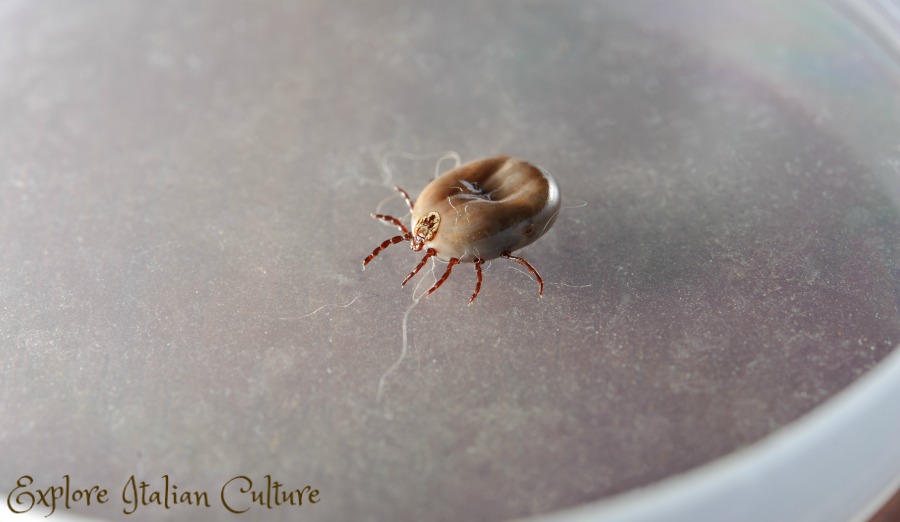 A dog tick in a dish. Don't handle ticks if you can avoid it.
A dog tick in a dish. Don't handle ticks if you can avoid it.They've got eight legs which squirm mercilessly when they're pulled out, and they burrow into their victim with their mouth. They begin as a light-ish brown colour and quite small. As they suck the blood from their host, they become very large and dark brown.
The disease is carried in their body fluids which they will inject if they think they're under attack.
The critical thing about removing ticks is that the mouth pieces must be taken out whole. If they're broken, the tick is likely to have injected disease into the bloodstream.
Dog Tick Treatment
- Getting rid of ticks
The best treatment for ticks is prevention, which is possible in a number of ways.
Natural tick repellent
We avoid using chemicals on our dogs as often as possible, so we've tried natural repellents. They simply didn't work.
Tick collars
Again, we've paid a lot for a good quality tick and flea collar but they had no effect - possibly because our Maremma has very thick fur so the collar was not touching her skin.
These collars should not be used for dogs under 8lbs, which is why we haven't tried them on your little Yorkie.
Treating fleas: Advantage flea repellent
This is a well-known and very effective chemical-based treatment, available for both dogs and cats of all sizes. It's a liquid contained in a pipette which you simply administer to the skin between the dog's (or cat's) shoulder-blades.
Here is a link to purchase the Advantage flea repellent.
However, it does not deal with ticks. If you want to use it to get rid of fleas that's fine - but you'll need a tick repellent as well.
What if you find a tick on your dog?
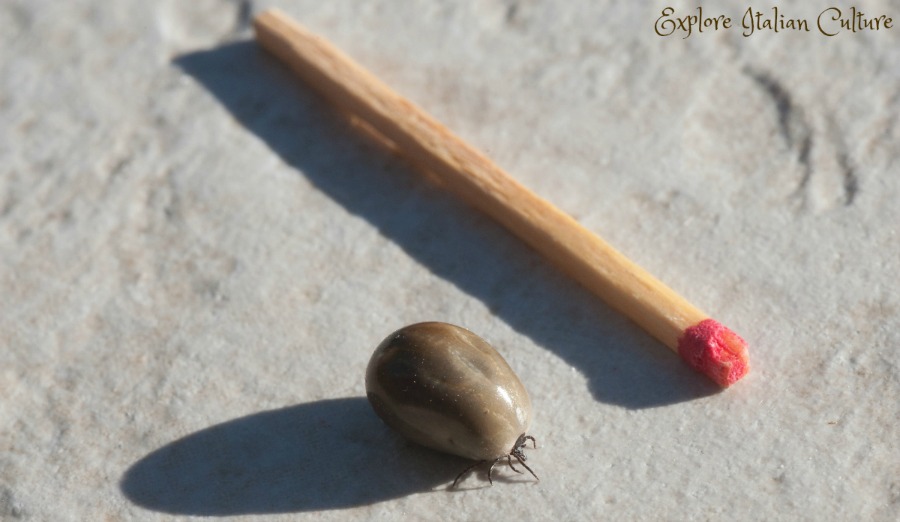 A dog tick after it has gorged on blood. They become large and a dark brown colour. Easily recognisable.
A dog tick after it has gorged on blood. They become large and a dark brown colour. Easily recognisable.Regular grooming is the best way to keep ticks at bay. Once they become large, they're easy to see and feel. Run your fingers through your dog's coat. Feel anything quite hard and lumpy? Check to see whether a tick has become attached.
#Ad
Dog Anti-Gulping Slow Feeding Bowl
Does your dog eat too quickly?! This Anti-Gulping Bowl helps your pet to slow down when eating and makes meals take longer to consume. This helps prevent choking, dangerous after-meal bloating, and improves digestion by eating at a healthy pace.
Read more and purchase on this link.
Tick removal
First and foremost, never put anything on a tick to try to remove it. You'll find all kinds of suggestions on the internet - salt, soap, alcohol, olive oil - none of them work, and you risk making the situation much worse.
Ticks don't take kindly to having things poured on them and their reaction is to embed themselves even more deeply into their host's skin. They then inject the contents of their stomach into the bloodstream and the risk of infection is greatly increased.
So just don't do it. There are other, much safer ways.
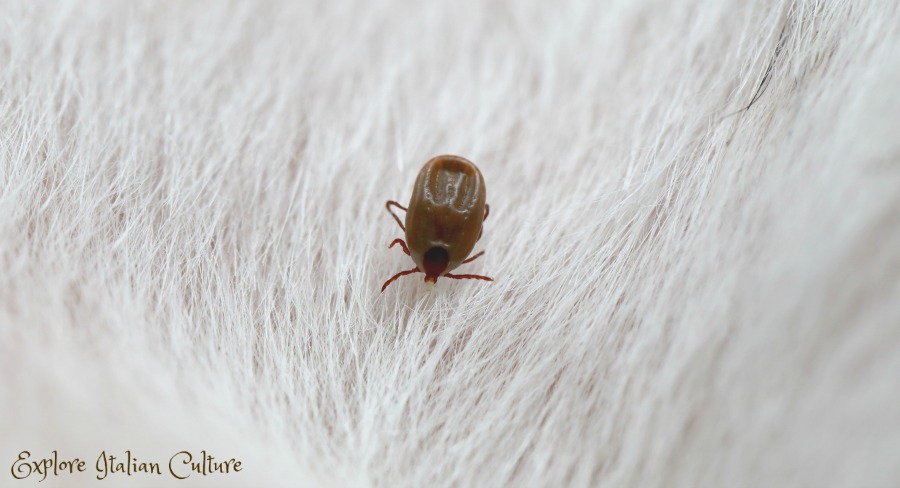 This tick was removed before it became too heavily engorged.
This tick was removed before it became too heavily engorged.Secondly, always wear gloves when you're dealing with ticks and wash your hands afterwards.
How to remove a tick safely
The main aim of tick removal is to take out the head, which will be embedded into the animal's skin. If it's left in, there's a strong likelihood of infection.
There are inexpensive implements on the market for doing this. We use two of them: this forked, plastic puller is our favourite. It's easy to use on both long- and short-haired dogs.
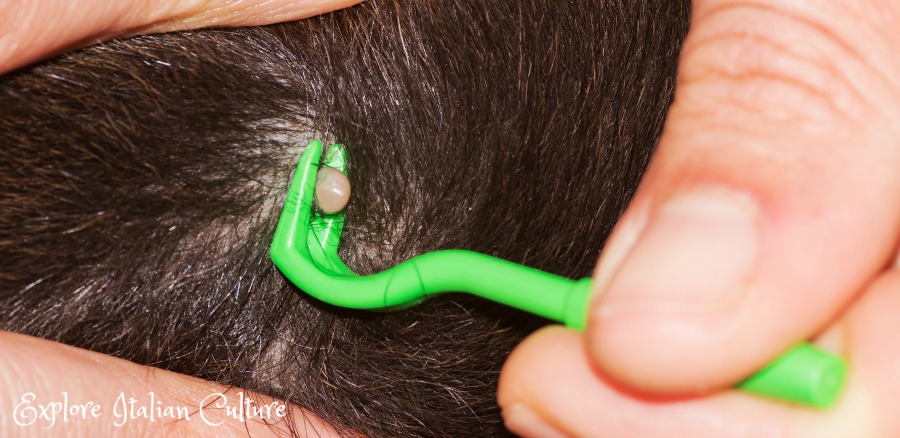
Simply place the prongs on either side of the tick, as close to the dog's skin as possible. When the tick is firmly lodged, keep fingers on the dog's skin with one hand and, with the other, rock the stick from side to side and then pull the tick firmly upwards.
If the tick has become firmly lodged it will be quite hard to remove. It helps to have someone to hold the dog's head to stop her from moving. Then, just keep pulling firmly and consistently - don't jerk. It will come in the end.
We keep a few of these in the house - they're small, and easy to lose. Make sure you buy different sizes - some ticks are bigger than others.
Want to buy one? Click here to purchase on Amazon.
Our second favourite method
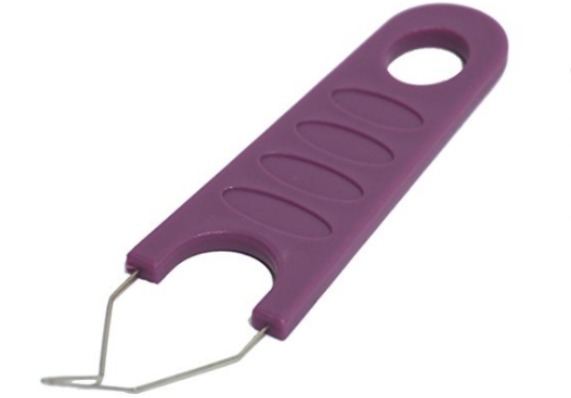
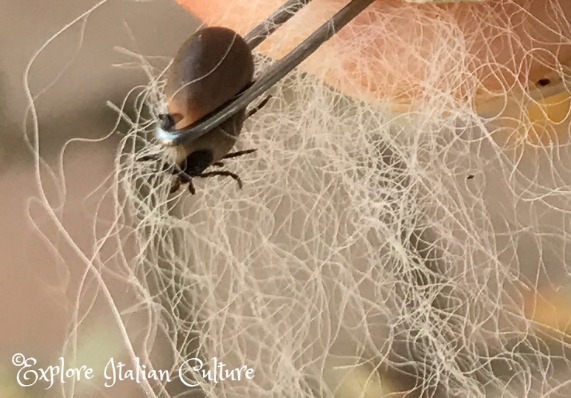
The second method we've found very simple and effective is this small, wire-based "key-type" tick remover. There are several available on the market: we chose this one because the wire which closes around the tick's body is thin enough to get right underneath it, close to the dog's skin.
Again, just place the wires under the tick's body as close to the animal's skin as possible, and pull gently and consistently. We've always found it effective at getting the entire tick out whole.
Pictured below is another effective Tick Remover that can be purchased on Amazon at a good price. CLICK HERE for further details.
Dog Tick Treatment
- Tick bites on dogs and cats
This is a tick with its mouth embedded into our Maremma, Luce's, skin. It wasn't particularly big at this point, but you can see that already the skin around the tick's head is pink and a little inflamed.
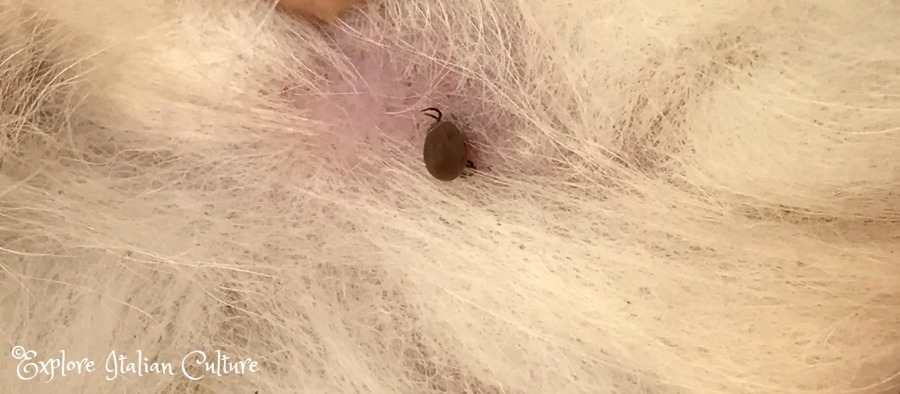
That's why it's important to spend time grooming your dog during tick season. The sooner it's removed, the better for the animal. If left in, at best the skin will become itchy and uncomfortable for your pet.
Once removed, swab the area where the tick was, with a little antiseptic on a cotton swab. We use Vetericyn (you can purchase it here).
Keep an eye on the area where the tick was, and if you see any signs of swelling, or if your dog appears unwell after you're removed it, or if you realise that the tick's mouth is still embedded in your dog after you've removed the body, see your veterinary practitioner straight away. Your dog will probably require antibiotics.
Disposing of ticks
Never just try to squash ticks. You need to try to control them on your land, and squashing won't do it - they're very resilient.
We put the ticks into kitchen paper and set fire to it with a match. Not very Zen - but it does get rid of them very effectively.
Never touch a tick with your bare hands if you can help it. Wear gloves when you're disposing of them and wash your hands thoroughly afterwards.
A word about Lyme disease
Remember: it would be very unusual to catch Lyme disease in Italy. If your dog has been bitten by a tick and you're worried about the disease, the symptoms a dog will display are:
- Fever
- Loss of appetite
- Walking stiffly, often with an arched back
- Being sensitive to touch.
If you see any of these symptoms in your dog or cat after a tick bite, take her to the vet straight away. A course of antibiotics is likely to be prescribed, which must be completed.
 The tell-take sign of Lyme disease in humans.
The tell-take sign of Lyme disease in humans.Ticks can move from dogs and cats to humans. Removal from human skin is exactly the same process as for animals. It's not pleasant, but it's not difficult.
Humans can also develop Lyme disease, although it's very rare. General symptoms are tiredness and aching arms and legs.
The tell-tale sign, although not everyone will develop it, is a very distinctive rash which will develop within hours of being bitten. It starts out red but develops to look like a bull's-eye - something like this picture.
If this happens to you, don't panic - it is treatable with a course of antibiotics. Simply get to a doctor as soon as you can.
The quicker it's diagnosed, the easier it is to treat.
Here's more information about ticks and humans
This website, called "Doctors in Italy", has good information about ticks and humans, in particular how to recognise symptoms and what to do if you think you may be infected.
